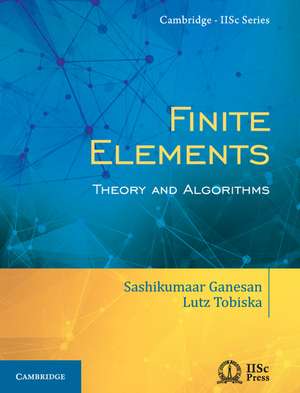Finite Elements: Theory and Algorithms: Cambridge IISc Series
Autor Sashikumaar Ganesan, Lutz Tobiskaen Limba Engleză Hardback – 10 mai 2017
Preț: 360.96 lei
Preț vechi: 462.70 lei
-22% Nou
Puncte Express: 541
Preț estimativ în valută:
69.07€ • 73.86$ • 57.59£
69.07€ • 73.86$ • 57.59£
Carte indisponibilă temporar
Doresc să fiu notificat când acest titlu va fi disponibil:
Se trimite...
Preluare comenzi: 021 569.72.76
Specificații
ISBN-13: 9781108415705
ISBN-10: 1108415709
Pagini: 216
Dimensiuni: 190 x 248 x 15 mm
Greutate: 0.47 kg
Editura: Cambridge University Press
Colecția Cambridge University Press
Seria Cambridge IISc Series
Locul publicării:Cambridge, United Kingdom
ISBN-10: 1108415709
Pagini: 216
Dimensiuni: 190 x 248 x 15 mm
Greutate: 0.47 kg
Editura: Cambridge University Press
Colecția Cambridge University Press
Seria Cambridge IISc Series
Locul publicării:Cambridge, United Kingdom
Cuprins
Preface; 1. Sobolev spaces; 1.1. Banach and Hilbert spaces; 1.2. Weak derivatives; 1.3. Sobolev spaces; 2. Elliptic scalar problems; 2.1. A general elliptic problem of second order; 2.2. Weak solution; 2.3. Standard Galerkin method; 2.4. Abstract error estimate; 3. Finite element spaces; 3.1. Simplices and barycentric coordinates; 3.2. Simplicial finite elements and local spaces; 3.3. Construction of finite elements spaces; 3.4. The concept of mapped finite elements: affine mappings; 3.5. Finite elements on rectangular and brick meshes; 3.6. Mapped finite elements: general bijective mappings; 3.7. Mapped Qk finite elements; 3.8. Isoparametric finite elements; 3.9. Further examples of finite elements in C0 and C1; 4. Interpolation and discretization error; 4.1. Transformation formulas; 4.2. Affine equivalent finite elements; 4.3. Canonical interpolation; 4.4. Local and global interpolation error; 4.5. Improved L2 error estimates by duality; 4.6. Interpolation of less smooth functions; 5. Biharmonic equation; 5.1. Deflection of a thin clamped plate; 5.2. Weak formulation of the biharmonic equation; 5.3. Conforming finite element methods; 5.4. Nonconforming finite element methods; 6. Parabolic problems; 6.1. Conservation of energy; 6.2. A general parabolic problem of initial boundary value problems; 6.3. Weak formulation of initial boundary value problems; 6.4. Semidiscretization by finite elements; 6.5. Time discretization; 6.6. Finite elements for high-dimensional parabolic problems; 7. Systems in solid mechanics; 7.1. Linear elasticity; 7.2. Mindlin–Reissner plate; 8. Systems in fluid mechanics; 8.1. Conservation of mass and momentum; 8.2. Weak formulation of the Stokes problem; 8.3. Conforming discretizations of the Stokes problem; 8.4. Nonconforming discretizations of the Stokes problem; 8.5. The nonconforming Crouzeix–Raviart element; 8.6. Further inf–sup stable finite element pairs; 8.7. Equal order stabilized finite elements; 8.8. Navier–Stokes problem with mixed boundary conditions; 8.9. Time discretization and linearization of the Navier–Stokes problem; 9. Implementation of the finite element method; 9.1. Mesh handling and data structure; 9.2. Numerical integration; 9.3. Sparse matrix storage; 9.4. Assembling of system matrices and load vectors; 9.5. Inclusion of boundary conditions; 9.6. Solution of the algebraic systems; 9.7. Object-oriented C++ programming; Bibliography; Index.
Recenzii
'The book is written in a very traditional and straightforward style of theory and proof. The organization of the material makes it accessible for the reader to gain a foundational understanding of the topics … This book provides a readable, concise introduction to finite elements. Summing Up: Recommended.' S. L. Sullivan, CHOICE
Notă biografică
Descriere
An easy-to-understand guide covering the key principles of finite element methods and its applications to differential equations.









